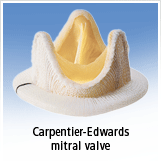Porcine Valves – What is A Porcine Heart Valve Replacement?
By Adam Pick on August 27, 2007
I just received an email from Eddie who is preparing for his heart valve replacement surgery. Eddie has mitral valve prolapse and severe mitral regurgitation. Eddie is 67 years old and is considering a tissue valve. Specifically, Eddie is leaning towards a porcine valve (aka a pig valve) and has several questions.
Eddie writes, “Adam – My surgeon has had a lot of success with porcine heart valve transplants. But, I still have questions including… What exactly is a porcine valve? Do you have any pictures or images of porcine valves? Are there any adverse effects of using a porcine valve? Are porcine valves safe? Thanks, Eddie.”
These are critical questions for the valve replacement selection process. That said, I’m going to do my best to answer Eddie’s questions about porcine valves.

First, let’s see what a porcine valve looks like. While there are several porcine valve manufacturers, above you will find a picture of an Edwards Lifesciences’ mitral valve replacement, known as the Carpentier-Edwards valve. Recently, I toured Edwards manufacturing center and learned how porcine valves are manufactured.
So you know, a porcine valve replacement is actually taken from the heart of a pig. I know that sounds a little odd…. But, porcine valves have been used in heart valve replacement surgery for over 20 years. That makes pig valves a very safe and very credible alternative for patients requiring valve replacement.
As you would imagine companies like Edwards, Medtronic and St. Jude have invested huge amounts of money to enhance the durability and performance of porcine valves over time. In fact, a porcine valve is now estimated to last up to 15 years once it is transplanted in the human heart. Still, most tissue valves, including porcine valves, are not as durable as the mechanical valve replacements which are made substances including titanium, Teflon and steel.
Obviously, this is one of the downsides of porcine valves as porcine valve leaflets tend to calcify and degenerate. This can lead to a collapsed pig valve in the human heart. However, some recent studies are beginning to challenge that adverse effect of pig valves.
Ultimately, reports suggest that since younger patients have a greater calcium metabolism, bioprosthetic tissue valves tend to last best in senior citizens. Once a bioprosthesis is implanted, the valve itself does not require any type of anti-coagulant drugs (Coumadin). The degeneration is simply a gradual process, as it grows with the body. That is why younger patients typically opt for mechanical valve replacements so that re-operations are not required.
Related Article:
I hope that helps explain a little more about porcine valves and pig valve replacements. If you have any questions, please let me know.
Keep on tickin!
Adam
|
Mark Shearon says on December 20th, 2007 at 11:13 am |
|
My dad had pig valve “installed” last week, and we have a question I can’t find the answer to: what strain of pig is most commonly used when harvesting valves for human implantation? |
 |
|
Vivian Garcia says on February 15th, 2008 at 4:55 pm |
|
Question? My 77 yo mother had a pig valve replacement 1 year on 2/28/08. She was in the hospital in 9/2007 with CHf and now the surgeon is saying that the valve has narrowed and my understanding is that they should last 10 to 12 years. Why does this happen? Manufacture? Surgeon? Why? Tks |
 |
|
Suzanne says on August 1st, 2008 at 2:33 pm |
|
Hi My mom had a porcine valve in 1999. She is now 74 years old. I see the life expectancy is 10-15 years. She is presently not having any problems. Do they last more than 15 years. |
 |
|
Kim says on March 20th, 2012 at 9:01 am |
|
Hi! I am 32 yrs old and have had 2 valve replacements. My first valve was a pig. my new one is a cow. My surgeon told me that the bovine ( cow valves) have more lifespan then the pigs. My pig lasted for 10 years and my cow is supposed to last 15. Really from my surgeons explanations it is all in how you take care of yourself to make your valve last. BUT over the years the valve can narrow as well it is something we really have no control over. Good Luck to all who have had replacements!! hope your piggys or moo cows last a long time!! |
 |
|
Reginald Hughes says on January 13th, 2014 at 8:06 pm |
|
Adam, |
 |
|
Jeanne says on June 21st, 2015 at 5:22 pm |
|
Yes I’d like to know the answer to that question and I’d also like to know if these pigs are grown organically for medicinal purposes or do they just take the valve of pigs raise for meat. How can I find out this information? I have to meet with a cardiac surgeon next week and need to decide between mechanical or a porcine valve I’m 62 years old but very young in spirit and don’t want to be placed on Comitan any suggestions |
 |












